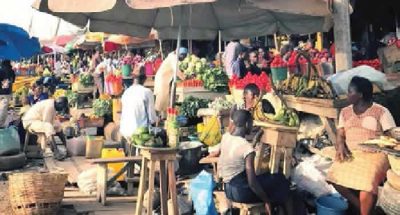
Experts have stated that the stability in Nigeria’s exchange rate market and seasonal farming are the major reasons headline inflation figures continued to slide.
It would be recalled that the National Bureau of Statistics (NBS) had in a report said Headline inflation rate eased to 22.22 percent when compared to the May 2025 headline inflation rate of 22.97 percent.
The drop, which is the third in the last three month was a marginal decrease of 0.76 percent compared to the May 2025 Headline inflation rate.
The report however stated that the Consumer Price Index (CPI) rose to 123.4 in June 2025, reflecting a 2.0-point increase from the preceding month (121.4).
On a year-on-year basis, the inflation rate was 11.97 percent lower than the rate recorded in June 2024 (34.19 percent).
“This shows that the Headline inflation rate (year-on-year basis) decreased in June 2025 compared to the same month in the preceding year (i.e., June 2024), though with a different base year, November 2009 = 100.”
It added that on a month-on-month basis, the Headline inflation rate in June 2025 was 1.68 percent, which was 0.15 percent higher than the rate recorded in May 2025 (1.53 percent).
“This means that in June 2025, the rate of increase in the average price level was higher than the rate of increase in the average price level in May 2025.
It said Food inflation rate in June 2025 was 21.97 percent on a year-on-year basis.
“This was 18.90 percent lower compared to the rate recorded in June 2024 (40.87 percent). The significant decline in the annual food inflation figure is technically due to the change in the base year. On a month-on-month basis, the Food inflation rate in June 2025 was 3.25 percent, up by 1.07 percent compared to May 2025 (2.19 percent). The increase can be attributed to the rate of increase in the average prices of Green Peas (Dried), Pepper (Fresh), Shrimps (white dried), Crayfish, Meat (Fresh), Tomatoes (Fresh), Plantain Flour, Ground Pepper, etc.”
“The average annual rate of Food inflation for the twelve months ending June 2025 over the previous twelve-month average was 28.28 percent, which was 7.06 percent points lower compared with the average annual rate of change recorded in June 2024 (35.35 percent).”
It went on to state that “All items less farm produces and energy” or Core inflation, which excludes the prices of volatile agricultural produces and energy, stood at 22.76 percent in June 2025 on a year-on-year basis; declined by 4.64 percent when compared to the 27.4 percent recorded in June 2024.
“On a month-on-month basis, the Core Inflation rate was 2.46 percent in June 2025, up by 1.36 percent compared to May 2025 (1.10 percent). The average twelve-month annual inflation rate was 24.14 percent for the twelve months ending June 2025, which was 0.07 percent points higher than the 24.06 percent recorded in June 2024.
States profile
For states analysis, it said All Items inflation rate on a Year-on-Year basis was highest in Borno (31.63 percent), Abuja (26.79 percent), and Benue (25.91 percent), while Zamfara (9.90 percent), Yobe (13.51), Sokoto (15.78 percent) recorded the lowest rise in Headline inflation on Year-on-Year basis.
But on a Month-on-Month basis the highest increases were in Ekiti (5.39 percent), Delta (5.15 percent), Lagos (5.13 percent), while Zamfara (-6.89 percent), Niger (-5.35 percent) and Plateau (-4.01 percent) recorded the lowest rise in Month-on-Month inflation.
Food inflation in states was highest in Borno (47.40 percent), Ebonyi (30.62 percent), Bayelsa (28.64 percent), while Katsina (6.21 percent), Adamawa (10.90 percent), and Sokoto (15.25 percent) recorded the slowest rise on Year-on-Year basis.
But it up in Enugu (11.90 percent), Kwara (9.97 percent), and Rivers (9.88 percent) while Borno (-7.63 percent), Sokoto (-6.43 percent) and Bayelsa (-6.34 percent), recorded decline in Food inflation on monthly comparison.
The report disclosed that urban inflation on a year-on-year basis was 22.72 percent, 13.83 percent points lower compared to the 36.55 percent recorded in June 2024. But on a month-on-month basis, the Urban inflation rate was 2.11 percent in June 2025, up by 0.71 percent compared to May 2025 (1.40 per cent). The corresponding twelve-month average for the Urban inflation rate was 28.16 percent in June 2025. This was 3.92 percent points lower compared to the 32.08 percent reported in June 2024.
Meanwhile, the rural inflation rate was 20.85 percent on a year-on-year basis. This was 11.24 percent points lower compared to the 32.09 percent recorded in June 2024.
“On a month-on-month basis, the Rural inflation rate in June 2025 was 0.63 percent, down by 1.2 percent compared to May 2025 (1.83 percent). The corresponding twelve-month average for the Rural inflation rate in June 2025 was 24.65 percent. This was 3.5 percent points lower compared to the 28.15 percent recorded in June 2024.
Pressure on prices remains – CPPE
The Centre for the Promotion of Private Enterprise [CPPE] described the steady decline in headline inflation for the third consecutive month as “salutary.”
However, it noted that concerns remain “as the month on month figures continue to reflect persistent pressures on prices.”
In its comment on the inflation report, the centre said, “While the year on year CPI decelerated from 22.97% in May to 22.22% in June; the month on month CPI rose from 1.53% in May to 1.68 in June 2025. Year on year food inflation also grew from 21.14 in May to 21.97 in June. Core inflation similarly increased from 22.28 in May to 22.76 in June.”
According to it, logistics costs, insecurity, foreign exchange cost, seasonality of crop production systems and cost of imports continue to be the major drivers of inflation in the economy.
The statement added, “From a policy perspective therefore, more attention needs to be paid to these variables.
However, it is curious that despite the stability in the exchange rate, core inflation is still on the upward trend. Greater attention needs to be paid to the activation of trade policy instruments to bring down imported input cost in the economy.
“Tariff policies need to be further recalibrated to ease the cost of critical inputs for the production and service sectors of the economy. The exchange rate for the computation of import duty needs to be reviewed to ease trade costs.
While acknowledging investments by the Federal and state governments to boost agricultural production, it noted that the dramatic appreciation of the currency of neighbouring countries [the CFA] against the naira “has created a huge incentive for the export of Nigerian products, especially agricultural products, to these countries.”
“Nigerian products are now incredibly cheaper for these countries to buy. This is also taking a toll on domestic supply of food. The challenge therefore is to scale up domestic production,” it added.
Exchange rate stability, a factor – Expert
Speaking with Daily Trust, an economic expert, Ebo Ayodeji said June inflation dropped due to the stability of the naira and relatively contained energy prices.
“This largely due to continued FX stability and minimal volatility in energy prices. However, food inflation remains a concern due to heightened insecurity in key food-producing areas like Benue State. A mix of statistical and policy-driven factors also contributed.”
Naira depreciates again
The naira value depreciated against the US dollar at the foreign exchange market due to increased demand for US dollars at the official window.
Data from the Central Bank of Nigeria (CBN) showed that spot fx rate was quoted at N1530.25 per greenback. Further details revealed that the transaction rate reached an intraday high of N1533 and briefly touched N1527 per dollar before it closed at N1531.
The exchange rate depreciated amidst rising external reserves, which printed higher at $37.638 billion at the beginning of the week, according to CBN Update, following a series of inflows.(Daily trust)

